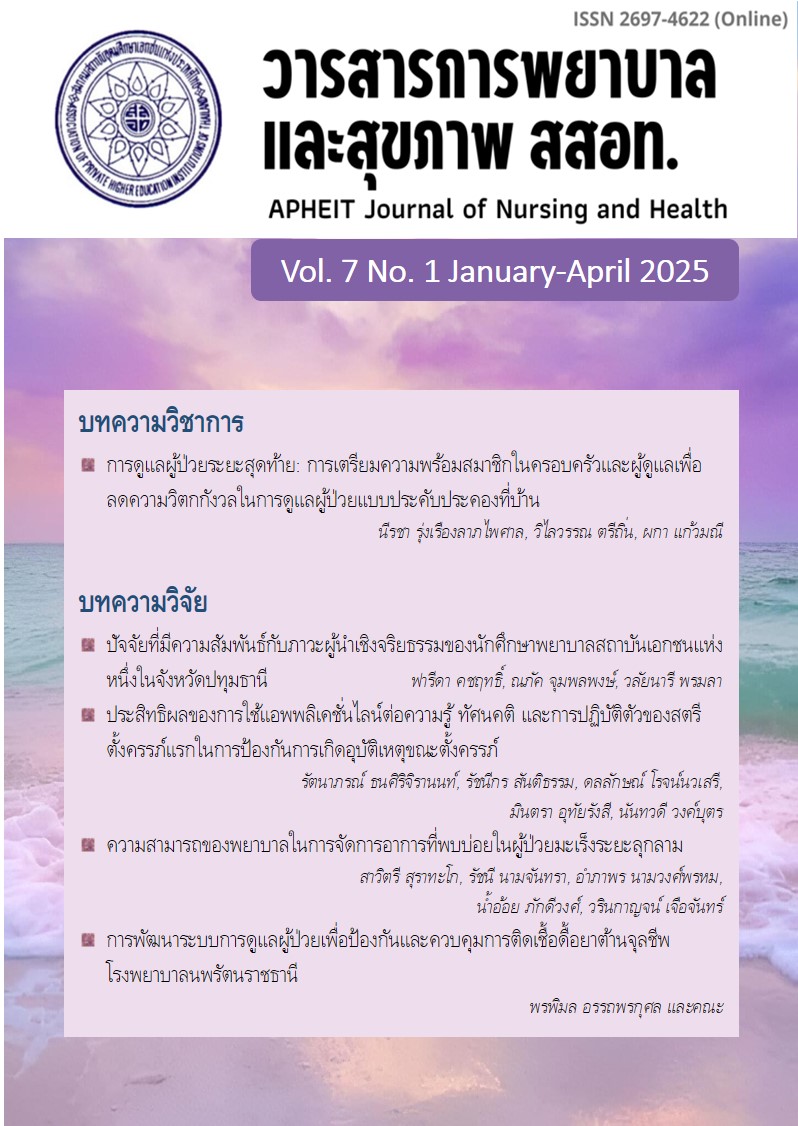Effectiveness of Line Application Usage on Knowledge, Attitude, and Practice among Primigravida in Prevention of Accidents during Pregnancy
Main Article Content
Abstract
This quasi-experimental research aimed to investigate the effectiveness of using the LINE application on the knowledge, attitude, and practice of primigravida in preventing accidents during pregnancy. The sample comprised 50 primigravida, divided equally into an experimental group and a control group, with 25 participants in each. The experimental group received information on accident prevention during pregnancy through the LINE application, while the control group received standard care. The instruments for conducting research and collecting data included the LINE application, a personal information questionnaire, a knowledge assessment form, an attitude assessment form, and a practical assessment form. The content validity index (CVI) was 1. The reliability of the knowledge assessment was tested using KR 20, yielding a value of .83, and the attitude assessment and practical assessment were tested with Cronbach's alpha coefficient statistics, both yielding a value .77. Data were analyzed using descriptive statistics and comparisons were made using independent t-test and dependent t-test.
The results found that after the intervention, the average scores of knowledge, attitude, and practice of the experimental group were significantly higher than the control group (p<.001, p<.05, p<.01, respectively) and the average post-intervention scores of knowledge, attitude, and behavior of the experimental group were significantly higher than their pre-intervention scores (p<.001, p<.01, p<.05, respectively). Therefore, it is recommended that the LINE application be utilized to educate pregnant women in the early stages of pregnancy, in order to timely and accurate access to information for the prevention of pregnancy-related accidents.
Article Details

This work is licensed under a Creative Commons Attribution-NonCommercial-NoDerivatives 4.0 International License.
เนื้อหาและข้อมูลในบทความที่ลงตีพิมพ์ในวารสารการพยาบาลและสุขภาพ สสอท. ถือเป็นข้อคิดเห็นและความรับผิดชอบของผู้เขียนบทความโดยตรง ซึ่งกองบรรณาธิการวารสารไม่จำเป็นต้องเห็นด้วย หรือร่วมรับผิดชอบใดๆ
บทความ ข้อมูล เนื้อหา รูปภาพ ฯลฯ ที่ได้รับการตีพิมพ์ในวารสารการพยาบาลและสุขภาพ สสอท. ถือเป็นลิขสิทธิ์ของวารสารการพยาบาลและสุขภาพ สสอท. หากบุคคลหรือหน่วยงานใดต้องการนำทั้งหมด หรือส่วนหนึ่งส่วนใดไปเผยแพร่ หรือเพื่อกระทำการใดๆ จะต้องได้รับอนุญาตเป็นลายลักษณ์อักษรจากวารสารการพยาบาลและสุขภาพ สสอท. ก่อนเท่านั้น
References
กลุ่มอนามัยมารดาและเด็กปฐมวัย กรมอนามัย. (2567). วิเคราะห์สถานการณ์การตายมารดาของประเทศไทย ปีงบประมาณ 2567. สืบค้น 20 มีนาคม 2567, จาก https://hp.anamai.moph.go.th/web-upload/4xceb3b571ddb70741ad132d75876bc41d/tinymce/OPDC/OPDC2568F/IDC32/OPDC2568_IDC3-2_01-1.pdf
ขวัญฤดี ฮวดหุ่น. (2560). อิทธิพลของแอพพลิเคชั่นไลน์ในการสื่อสารยุคปัจจุบัน. วารสารศิลปการจัดการ, 1(2), 75-88.
นิพิฐพนธ์ สนิทเหลือ, วัชรีพร สาตร์เพ็ชร์, และญาดา นภาอารักษ์. (2562). การคำนวณขนาดตัวอย่างด้วยโปรแกรมสำเร็จรูป G*POWER. วารสารวิชาการ สถาบันเทคโนโลยีแห่งสุวรรณภูมิ, 5(1), 496-507.
ปิยะพร ศิษย์กุลอนันต์, และพรสวรรค์ คำทิพย์. (2563). ผลของโปรแกรมการจัดการตนเองและการติดตามด้วยแอพพลิเคชั่น LINE ต่อพฤติกรรมการรับประทานอาหาร การออกกำลังกายแกว่งแขน และระดับน้ำตาลในเลือดของสตรีที่มีภาวะเบาหวานขณะตั้งครรภ์. วารสารสภาการพยาบาล, 35(2), 52-69.
สุจิตรา เทียนสวัสดิ์. (2563). การพัฒนาเครื่องมือสำหรับการวิจัยทางการพยาบาล. เชียงใหม่: สยามพิมพ์นานา.
เสาวนีย์ อินทรเนตร, และรพีพรรณ นาคบุบผา. (2567). ผลของโปรแกรมส่งเสริมความรอบรู้ด้านสุขภาพด้วยแอปพลิเคชันไลน์ต่อพฤติกรรมการป้องกันการเจ็บครรภ์คลอดก่อนกำหนดในสตรีตั้งครรภ์แรก. วารสารวิทยาลัยพยาบาลพระจอมเกล้า จังหวัดเพชรบุรี, 7(2), 90-104.
Al-Thani, H., El-Menyar, A., Sathian, B., Mekkodathil, A., Thomas, S., Mollazehi, M., … Abdelrahman, H. (2019). Blunt traumatic injury during pregnancy: A descriptive analysis from a level 1 trauma center. European Journal of Trauma and Emergency Surgery, 45(3), 393–401. doi:10.1007/s00068-018-0948-1
Bloom, B. S., Hastings, J. T., & Madaus, G. F. (1971). Handbook on formative and summative evaluation of student learning. New York, NY: McGraw-Hill.
Cohen, J. (1988). Statistical power analysis for the behavioral sciences (2nd ed.). New Jersey, NJ: Lawrence Erlbaum Associates.
Cunningham, F. G., Leveno, K. J., Dashe, J. S., Hoffman, B. L., Spong, C. Y., & Casey, B. M. (2022). Williams obstetrics (26th ed.). New York, NY: McGraw-Hill.
Hrvatin, I., & Rugelj, D. (2021). Risk factors for accidental falls during pregnancy – a systematic literature review. The Journal of Maternal-Fetal & Neonatal Medicine, 35(25), 7015–7024. doi: 10.1080/14767058.2021.1935849
Irving, T., Menon, R., & Ciantar, E. (2021). Trauma during pregnancy. BJA Education, 21(1), 10–19.
doi: 10.1016/j.bjae.2020.08.005
Krathwohl, D. R., Bloom, B. S., & Masia, B. B. (1964). Taxonomy of education objective: The classification of educational goals, handbook II: Affective domain. New York, NY: Longman.
Madden, A.-M., & Meng, M.-L. (2020). Cardiopulmonary resuscitation in the pregnant patient. BJA Education, 20(8), 252-258. doi: 10.1016/j.bjae.2020.03.007
Physiopedia. (2025). The biomechanics of pregnancy. Retrieved March 20, 2025, from https://www.physio-pedia.com/The_Biomechanics_of_Pregnancy
Polit, D. F., & Beck, C. T. (2021). Nursing research: Generating and assessing evidence for nursing practice (11th ed.). Philadelphia: Wolters Kluwer.
